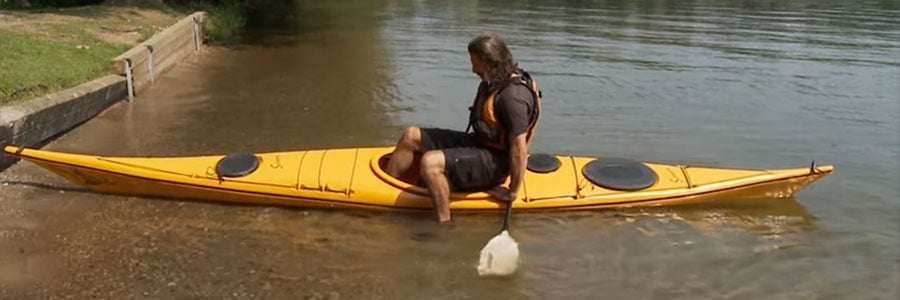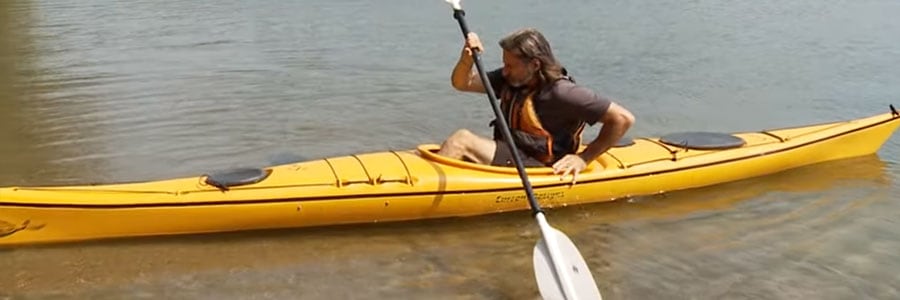The first step in becoming a good paddler is learning how to get in and out of a kayak.
Even though it seems straight forward, believe me, it is not as graceful as you think the first few times you try. You will fall into the water, but it gets better with experience.
There are a few tricks of the trade, though, which I will share with you now. They will increase your confidence while entering and exiting your yak and allow you to help others.
These methods work for getting in and out of inflatable kayaks, as well as hard shell models.
Contents
Entering your Kayak from the Beach or a Ramp
I’ve found that the easiest way to launch on the beach (or a ramp) is to position your kayak perpendicular to the shoreline. The bow (front) should point towards the shore, so the rear skeg (or rudder) does not touch the bottom.
It’s best to start in shallow water, at about ankle depth. Half of the hull should be touching the sand/ramp, with the other half floating in the water. Don’t be too close to shore, though, since you might get stuck in the sand after sitting down.
The paddle bridge method
The first way of entering a kayak is using the paddle as a bridge of support. Hence, “Paddle Bridge Method”. Be careful not to put too much weight on the paddle blade, though; you don’t want to damage it.
The straddle method
This method is getting into a kayak is more straightforward and is especially useful when entering inflatable yaks with large skegs protruding from the hull. You don’t want the skeg to break or bend as it touches the bottom.
It is not an overly complicated process but keeping your balance can sometimes be a little challenging.
Here is a great video by the Canadian Safe Boating Council demonstrating both methods of entering your kayak:
If you are paddling with someone else, you can ask them to steady your boat while you get in. From there, you can hold your friend’s kayak steady as they enter their boat.
Getting out of a Kayak at the Beach/Ramp
Getting out of your kayak and back onto the shore is done in reverse order. You can use either the straddle method, or the paddle bridge.
Getting out is much more challenging, though, since it is more difficult to find your balance and raise yourself.
Entering and Exiting A Kayak on Docks
Getting into and out of a kayak from a pier is easier if the pier is close to the water. For this reason, you always want to pick the lowest spot of the pier to enter & exit your boat.
Getting into your Kayak from the Pier
Find a low spot where the waves and wind will not blow your kayak away, and follow the steps below.
Here is a video to demonstrate this:
Exiting your Kayak to a Pier
Exiting your kayak onto a high dock is tricky. Here are the steps:
Re-entering a Kayak from the Water
All kayakers need to learn how to get back into their kayak after flipping over in deep water.
Here are the steps you’ll need to follow.
- Flip your kayak back quickly, so it takes on as little water as possible. This is important with sit-inside boats. To do this, reach over the other side of the boat, and pull it towards yourself with a strong movement.
- Place your paddle onto your kayak so it doesn’t float away or get in your way as you re-enter.
- Put both of your arms onto the boat, so it basically keeps you afloat.
- With a strong kick of your legs, propel yourself up onto the boat tummy down. Wiggle your way up until your belly button is in the center of the boat.
- Regain your balance as you lay on your kayak.
- Turn your body towards the cockpit, so you end up parallel with the kayak. Your legs should hang off of the sides of the boat.
- Sit up, and slide your buttocks into the cockpit.
- Pull your legs in, and you’re ready to go.
This self-rescue skill should be practiced to perfection in shallow water. A lot of people panic when they realize getting back into the boat is not a straightforward process.
Kayak entry/exit mistakes
If you don’t know what you’re doing, a lot can go wrong. Here are the most typical mistakes beginners make.
- Don’t stand into your kayak when entering from a pier. You will end up pushing it away and looking silly.
- Mind where you put your hands on the dock. Seashells, nails, and splinters are very common, don’t hurt yourself with them.
- Don’t hop into the kayak. You can lose your balance and flip over.
Every kayak trip starts and ends with getting in and out of your boat, so you should take some time to practice these entry and exit methods.


























